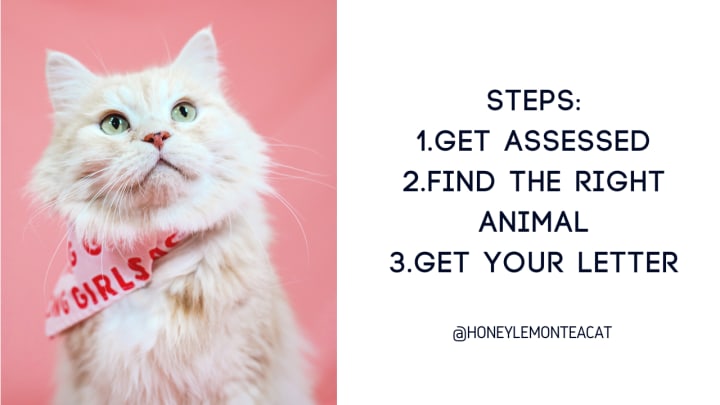How I Got an Emotional Support Animal
The pros, cons, and process of registering an E

Have you ever thought about how soothing it is to be around your pet? Considering having your pet as an Emotional Support Animal? Here's how I did it.
What is an ESA?
An emotional support animal (ESA) is prescribed to you by a licensed professional as a treatment plan for your underlying mental illness. A mental illness is defined as having an internal psychological disorder that is negatively affecting your daily functions and quality of life. This is important because a lot of us think that it takes a crazy person to be mentally ill.
You might be constantly fatigued, questioning every decision, or waking up from nightmares every single night. In reality, you might be depressed, suffer from an anxiety disorder, or have PTSD from a traumatic experience in the past. It's easy to cast these symptoms aside because of our current hustle culture. Later in the post, we’ll discuss how to get yourself sorted! If you want, you can do the prescreening here!
Benefits of Getting an ESA
1. In the US, having an ESA means you are protected in terms of Housing and Travel. This means that you can get around the no-pet clause for rent, and you can travel with your ESA as long as you have a letter from a state-recognized licensed mental health professional.
Living in Canada, like me eh?
Laws for Housing in Canada vary per province. In B.C, there is no rent protection for ESA, meaning it’s up to the landlord to decide whether or not you can have the animal. I presented my letter to my landlord and they were very understanding. They made an exception to the no-pet clause, knowing that it will bring me good health. Not all landlords are like this, so please have this conversation with them, and do your research on your rights before going ahead.
2. Your pet doesn’t have to be service trained. This means virtually any pet can become an ESA if it fulfills the necessity of your treatment plan.
Downsides of an ESA
1. It costs money. Whether you’re going through a site like CertaPet or getting help from a licensed professional, you’re going to spend at least two hundred dollars. CertaPet costs $189 with my link. Getting a letter from a licensed professional might take you more than 1 session of therapy, which could cost you around $100-200 per session.
2. An ESA is not necessarily a trained service animal and you are responsible for the behaviour of your pet. This means if you have a rowdy pet, you might want to reconsider treating it as an ESA. An untrained animal can cause disturbances/damages in flights and housing situations. You have to be ready to train your animal on your own time.
Sounds good so far? Ready to continue? Let’s see the next steps!

1. Get Help from a Professional
First things first, we have to identify WHY you think you need an emotional support animal. Getting professional help will benefit you so much in the long run. You can start the prescreening here, or here for online counselling. If you qualify, you’ll be contacted by a mental health professional to talk about treatment plans and how your animal is going to help you get better.
2. Find Animals with the Right Temperament
I won’t get into the Cats vs. Dogs argument, but I will say that you should know the personality of your pet or ESA-to-be before committing to the process. Your pet should be able to mitigate your symptoms and not cause unnecessary stress.
If you’re adopting, be sure to meet them beforehand. I met my ESA, Honey Lemon Tea, at a Cat Cafe before adopting her. I made sure to ask the staff for recommendations of cats that are calm and sociable, as those are the traits that would benefit me the most.
Do your research. If you want to get a specific breed, like getting any other animal, be sure that you are capable of taking care of them. A high-maintenance breed might not be suitable for someone fighting depression. Let’s say if you’re having trouble getting out of bed every day, a dog that needs to go out 3 times a day might not be the one for you.
Adopt an older animal if you can. They are usually calmer and have a well-developed personality already. Generally what you see is what you get, different from puppies and kittens where they are still figuring themselves out.
3. Have Your Animal be on an Official Letter
Get your letter written by a mental health professional. CertaPet does screening, consulting, and letter writing for you, making it an easy process!
If you’re currently seeing a therapist, you can also ask them to write you a letter highlighting:
- The fact that you have a functional limitation due to your mental health issue
- Details of those limitations (concentration, sleep, etc.)
- Prescription of an ESA as a treatment plan for symptoms
- A request for accommodation of an ESA as set forth in the Human Rights Code[RSBC 1996] Chapter 210 Section 8
- The expiry date underlining reassessment (usually 1 year)
There is no such thing as a "Registered" pet from a "Registered" site. All you need for an ESA is a letter from a mental health professional outlining the information above!
The End.

I wish you all the best in your mental health journey, and hope that this has been helpful information!
This article is in no way affiliated or endorsed by Better Help or CertaPet. I am only using my personal experience as a way to guide others who might need extra support in getting an ESA. If you have further questions about my journey, feel free to DM on Instagram @honeylemonteacat. If you find this useful, please leave a $1 tip!
About the Creator
Kezia Parent
Cat-mom, photographer and after-school teacher. I love sharing new knowledge and perspectives. Follow my cat on instagram @HoneyLemonTeaCat !
Enjoyed the story? Support the Creator.
Subscribe for free to receive all their stories in your feed. You could also pledge your support or give them a one-off tip, letting them know you appreciate their work.






Comments
There are no comments for this story
Be the first to respond and start the conversation.